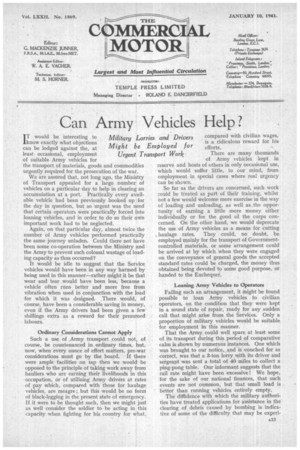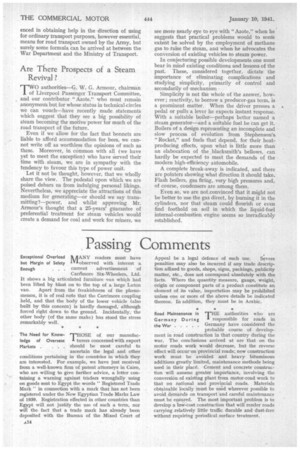Can Army Vehicles Help?
Page 15

Page 16

If you've noticed an error in this article please click here to report it so we can fix it.
I T would be interesting to know exactly what objections can be lodged against the, at least occasional, employment of suitable Army vehicles for the transport of materials, goods and commodities urgently required for the prosecution of the war.
We are asstred that, not long ago, the Ministry of Transport appealed for a large number of vehicles on a particular day to help in clearing an accumulation at a port. Practically every available vehicle had been previously booked up for the day in question, but so urgent was the need that certain operators were practically forced into loaning vehicles, and in order to do so their own important work had to be neglected.
Again, on that particular day, almost twice the number of Army vehicles performed practically the same journey unladen. Could there not have been some co-operation between the Ministry and the Army to prevent such colossal wastage of loading capacity as thus occurred?
It would be idle to suggest that the Service vehicles would have been in any way harmed by being used in this manner—rather might it be that wear and tear would have been less, because a vehicle often runs better and more free from vibration when used in conjunction with the load for which it was designed. There would, of course, have been a considerable saving in money, even if the Army drivers had been given a few shillings extra as a reward for their presumed labours.
Ordinary Considerations Cannot Apply Such a use of ,Army transport could not, of course, be countenanced in ordinary times, but, now, when every ounce of effort matters, pre-war considerations must go by the board. If there were ample facilities on tap then we would be opposed to the principle of taking work away from hauliers who are earning their livelihoods in this occupation, or of utilizing Army drivers at rates of pay which, compared with those for haulage vehicles, are meagre ; but this would be no form of black-legging in the present state of emergency. If it were to be thought such, then we might just as well consider the soldier to be acting in this capacity when fighting for his country for what, compared with civilian wages, is a ridiculous reward for his efforts.
There are many thousands of Army vehicles kept in reserve and hosts of others in only occasional use, which would suffer little, to our mind, from employment in special cases where real urgency can be shown.
So far as the drivers are concerned, such work could be treated as part of their training, whilst not a few would welcome more exercise in the way of loading and unloading, as well as the opportunity of earning a little more money either individually or for the good of the corps concerned. On the other hand, we would deprecate the use of Army vehicles as a means for cutting haulage rates. They could, no doubt, be employed mainly for the transport of Government. controlled materials, or some arrangement could be arrived at by which when they were engaged on the conveyance of general goods the accepted standard rates could be charged, the money thus obtained being devoted to some good purpose, or handed to the Exchequer.
Loaning Army Vehicles to Operators Failing such an arrangement, it might be found possible to loan Army vehicles to civilian operators, on the condition that they were kept in a sound state of repair, ready for any sudden call that might arise from the Services. Only a proportion of military vehicles would be suitable for employment in this manner.
That the Army could well spare at least some of its transport during this period of comparative calm is shown by numerous instances. One which was brought to our notice, and is vouched for as correct, was that a 3-ton lorry with its driver and sergeant was sent a total of 40 miles to collect a ping-pong table. Our informant suggests that the rail rate might have been excessive ! We hope, for the sake of our national finances, that such events are not common, but that small load is better than running vehicles entirely empty.
The diffidence with which the military authorities have treated applications for assistance in the clearing of debris caused by bombing is indicative of some of the difficulty that may be experi enced in obtaining help in the ,direction of using for ordinary transport purposes, however essential, means for road transport owned by the Army, but surely some formula can be arrived at between the War Department and the Ministry of Transport.
Are There Prospects of a Steam Revival ?
TWO authorities—Q. W. G. Armour, chairman oVf Liverpool Passenger Transport Committee, and our contributor " Azote," who must remain anonymous but for whose status in technical .circles we can vouch—have recently made statements which suggest that they see a big possibility of steam becoming the motive power for much of the road transport of the future.
Even if we allow for the fact that bonnets are liable to afford accommodation for bees, we cannot write off as worthless the opinions of such as these. Moreover, in common with all (we have yet to meet the exception) who have served their time with steam, we are in sympathy with the tendency to favour this type of power unit.
Let it not be thought, however, that we wholly share the view. The pedestal upon which we are poised debars us from indulging personal likings. Nevertheless, we appreciate the attractions of this medium for generating—or should we say transmitting?—power, and whilst approving Mr. Armour's thought that a 25-years' guarantee of preferential treatment for steam vehicles would create a demand for coal and work for miners, we see more nearly eye to eye with " Azote," when he suggests that practical problems would to some extent be solved by the employment of methane gas to raise the steam, and when he advocates the conversion of existing vehicles to steam power.
In conjecturing possible developments one must bear in mind existing conditions and lessons of the past. These, considered together, dictate the importance of eliminating complications and studying simplicity, primarily of control and secondarily of mechanism Simplicity is not the whole of the answer, however ; reactivity, to borrow a producer-gas term, is a prominent matter. When the driver presses a • pedal or pulls a lever he expects instant response. With a suitable boiler—perhaps better named a steam generator—and a suitable fuel he can get it. Boilers of a design representing an incomplete and slow process of evolution from Stephenson's "Rocket," and fuels that depend, for their heatproducing effects, upon what is little more than an elaboration of the _blacksmith's bellows, can hardly be expected to meet the demands of the modern high-efficiency automobile.
A complete break-away is indicated, and there are pointers showing what direction it should take. Flash boilers, gas firing, very high pressures and, of course, condensers are among them.
Even so, we are not.convinced that it might not be better to use the gas direct, by burning it in the cylinders, nor that steam could flourish or even find foothold on soil in which the liquid-fuel internal-combustion engine seems so ineradicably established.




















































